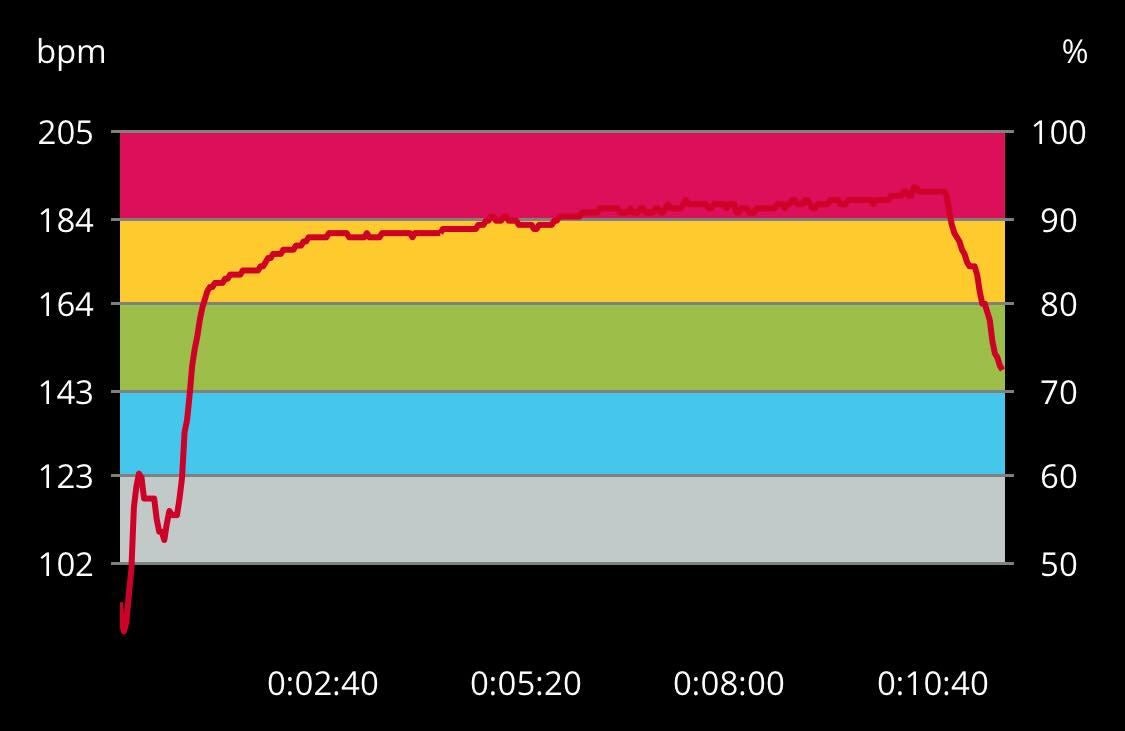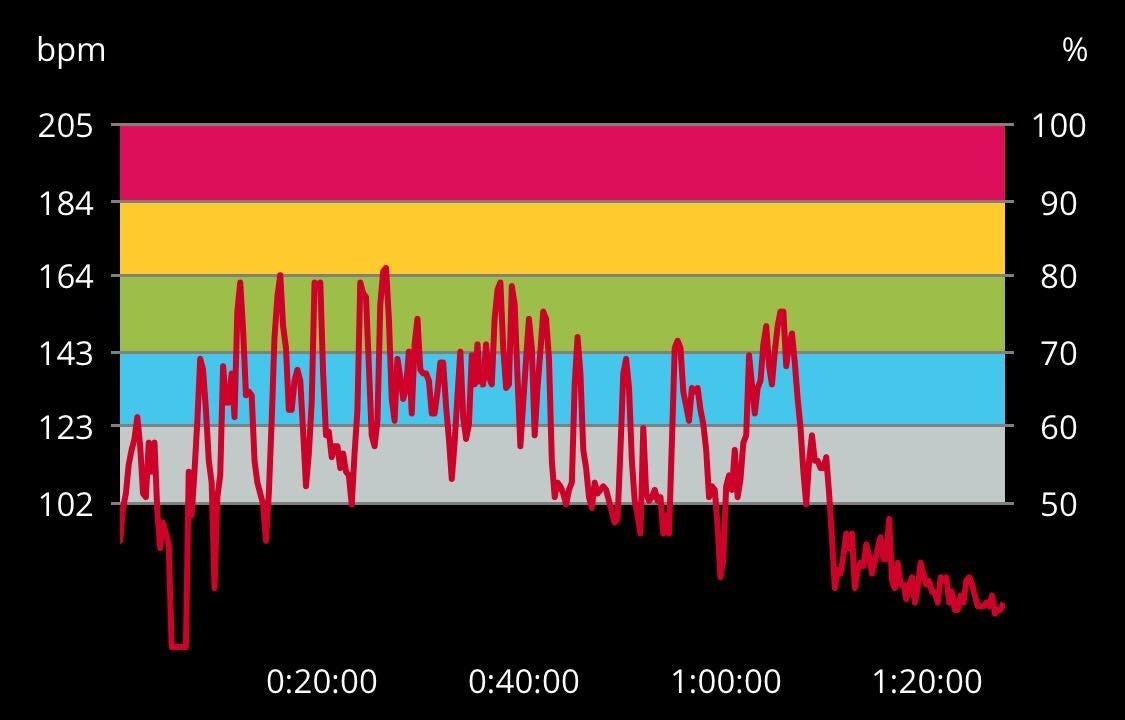Your heart beats faster when you’re working hard, so it’s a good way to tell if you’re exercising hard enough…right? Well, not exactly. Your heart rate is only a good gauge of effort in certain types of exercise. And it can even steer you wrong if the numbers are miscalibrated.
Don’t rely on heart rate tracking for calorie burn
If your fitness tracker tells you that you’ve burned a certain number of calories in a workout, it’s basing that number on your heart rate (plus a few personal details, like how big you are).
It’s mostly true that the higher your heart rate when doing a cardio workout, like running, the more calories you’re burning during that workout. But your watch can’t tell when your heart rate is high for another reason (you’re nervous or overheating, for example) in addition to your effort level.
This measure is also notoriously inaccurate for some activities. Running and cycling are pretty straightforward since you’re doing the same motion over and over, and since the way your legs move the pedals is probably not that different from whatever cyclist the app makers used to calibrate their formulas. But if you’re doing a barre workout, or Crossfit, or you’re enjoying a day on the ski slopes, how is the watch supposed to know exactly what you’re doing and how hard it is? Spoiler: It doesn’t.
Adding to the muddle is the fact that our calorie burn during exercise doesn’t tell us much about our total calorie burn, which is what we really care about. Our bodies are good at conserving energy in daily life when we’re burning a lot of calories during exercise. So you could burn 500 calories on a run only to be so tired afterward that you burn 400 fewer calories during the rest of the day.
Bottom line, if you care about how many calories you’re burning, you shouldn’t worry so much about what a heart rate tracker tells you. A better method is simply to adjust how many calories you eat based on whether the scale is going up or down.
Don’t worry about heart rate while you’re strength training
If you do a lot of cardio, you may be used to thinking of your heart rate as a good measure of intensity. The higher your heart rate during the workout, the harder you’re working. But that’s not true of strength training.
Think about this: If you’ve got a light weight, and you lift it over and over again, you’ll get your heart rate up and you’ll keep it up. For example, here’s the heart rate graph from me doing a set of kettlebell clean and jerks for ten minute straight:

That’s a hard workout and it’ll build some strength, but it’s nothing compared to one of my normal weightlifting workouts where I did barbell clean and jerks, clean pulls (sort of an explosive deadlift), jerk recoveries, and some core exercises on the floor for a total of over an hour. Most of these lifts were brief efforts that were heavy enough to get me breathing hard afterward. Those are the spikes on the graph. But then I would sit around for a few minutes to recover, and that’s where you see my heart rate dip down again.

From the heart rate graphs, we can see that the ten-minute set was a steady, relatively high effort workout from a cardio perspective. I couldn’t have gone much faster or heavier, since my cardiovascular system wouldn’t be able to get enough blood and oxygen to my muscles to sustain much more of an effort. From my lungs’ point of view, this looks a lot like going out for a tempo run.
On the other hand, the barbell workout wasn’t very taxing on my heart and lungs, and it’s not doing much to build my cardiovascular endurance. If you were to only judge these workouts by their heart rate graphs, the barbell workout would seem to be pointless.
But the cardio benefit is not the reason we strength train. Strength training challenges our muscles to get stronger. Heart rate doesn’t reflect how heavy or difficult the lift actually is. Just glancing at the graph, I can’t tell which set was 42 kilos and which was 49 kilos; I have to look at my training journal to see that. And if I were to compare this workout to one I did a few years ago, when I was less strong, it would probably look similar even though the weights would have been a lot lighter.
It’s important to understand this distinction, because if you only judge your strength workouts by your heart rate, you’ll be tempted to increase your average heart rate by doing more reps of lighter weight — basically turning them into cardio workouts. (That ten-minute kettlebell workout I used as an example? It’s really a middle ground between cardio and strength, providing a hard workout for my heart and lungs and only a medium one for my muscles.) If you want to get strong, you need to lift heavy, which necessarily means taking time to rest — and let your heart rate drop — between sets.
Use heart rate to gauge cardio intensity — with caveats
Now we come to the thing that heart rate does do well, which is gauging the intensity of cardio workouts like running and cycling.
So how do you turn that count of heartbeats into a measure of intensity? The simplest way is to use an app that converts your heart rate into a set of heart rate zones. In a five-zone system, if you head out for a LISS (low intensity steady state) jog, you should expect your heart rate to be in Zone 2 most of the time.
These zones are helpful in training because each zone has a slightly different training effect. Zone 2 training is great for building aerobic capacity without fatiguing you too much. Zones 3 and 4 teach your body to work a bit harder, but it’s hard to do as much work in these zones. So if you’re heading out for a long run, you might want to wear a heart rate monitor to make sure you’re staying in Zone 2 to get the benefits you’re going for; on another day, you might do a shorter workout that has you riding the line between Zone 4 and Zone 5 to train your body to handle hard efforts.
You don’t need to measure your heart rate to be able to train at these effort levels, though. Before smartwatches and heart rate monitors were common, coaches would tell runners to head out for an “easy run,” and recreational joggers would try to keep their pace “conversational,” literally the effort level where you are breathing easily enough that you can hold a conversation. Meanwhile, if you’re doing high-intensity intervals, you don’t need a heart rate monitor to tell you when you’re sprinting all-out. You can feel it.
How to train with heart rate, if you still want to
If you’re just starting to take up cycling or running or another steady-state cardio activity, you can train by effort level instead of relying on heart rate. And if you want to pay attention to your heart rate, I’d encourage you to simply notice what heart rate you see at each subjective effort level:
- What number do you see when you’re walking or warming up, and not really putting any effort in yet?
- What number do you see when you’re exercising at a pace where you could still easily hold a conversation?
- What number do you see when you’re working at an effort level that is hard to keep up, but that you could do for maybe half an hour, or even more if you really had to?
- What number do you see when you’re going all-out? (Probably no number at all, because you’re too exhausted and distracted to look at your watch, but you can check afterwards.)
Those numbers respond roughly to Zones 1, 2, 4, and 5, with Zone 3 being in between that easy pace and that gruelling-but-I-can-hold-on pace.
The reason I’m asking you to notice and not calculate is that when you’re new to exercise, your calculations are probably going to be wrong. The standard description of heart rate zones is as a percentage of your maximum heart rate, but if you’ve never run an all-out, pukeworthy, race-day effort, you have no idea what your max really is.
There are various formulas out there to find your max; the simplest is to subtract your age from 220, so a 30-year-old would have a max heart rate of 190. The problem with that approach is that it’s a one-size-fits-all formula that fits almost nobody.
Here’s an example: I’m 41 and my actual max heart rate is somewhere north of 205. If I relied on the formula, a heart rate of 152 would fit into Zone 4, when actually I know that that’s a nice easy Zone 2 pace for me. When I did that ten-minute kettlebell set, I spent fully half of it at a heart rate above what the formula thinks is physically possible for me. And then some people have max heart rates that are lower than the formula would predict, and they have the opposite problem. They’ll be breathless, panting, legs burning, and their watch will say they’re in Zone 3. That’s not right, either. Training with miscalibrated zones can leave you either exhausted or under-trained.
Your heart rate will also change with body position, like how I’ve noticed that I can’t get my heart rate as high when I’m cycling as when I’m running. (Swimming, where your body is horizontal, tends to have lower numbers still.)
So don’t worry about your exact heart rate at first. Higher means your cardiovascular system is working harder; lower means you’re at an easier effort. Keep an eye on how your effort feels at a given heart rate, and adjust your “max” in your app’s settings to whatever number makes the zones make sense. And remember that heart rate is only a tool to help you dial in your training. Your body knows how hard it’s working whether you’re wearing a smartwatch or not.

Leave a Reply
You must be logged in to post a comment.